Hey Prompt Entrepreneur,
This guide focuses on LinkedIn Growth using AI.
This is an exciting topic because LinkedIn is the key to B2B (business to business) growth. This is when you sell not to consumers but to companies.
This is a different type of market that requires more work to crack but has higher rewards.
For example think of selling educational courses. In B2C (business to consumer) marketing we might sell a course for a few hundred dollars.
In the B2B market a very similar course, presented and marketed differently, sells for thousands of dollars instead.
LinkedIn is the key to tapping into these higher ticket markets.
This week we’ll be looking at:
Part 1: LinkedIn Niche
Part 2: LinkedIn Content Creation
Part 3: LinkedIn Audience Engagement
Part 4: LinkedIn Growth
Part 5: Monetising LinkedIn
Let’s get started:
LinkedIn Niche
1. Niching down
First up, as always, we’re going to work on locking down our niche. We’ll take a set of steps to research and decide how best to present your particular skills and offer on LinkedIn.
The basic idea is to start with some niche ideas, look at competitors to see what they are doing, use LinkedIn to get the exact language we need to use and then convert that language into our profile details and headline.
This foundational stage is the key to dominating on LinkedIn – very few people bother to research and consciously build or their niche. By doing so you’ll be ahead of the competition.
We need to start with a seed keywords here. It needs to be connected to our business and what we will eventually be selling using LinkedIn.
For example mine would be “AI” or “artificial intelligence”. This is a broad definition of my area.
For you it might be Digital Marketing, Cosmetics, Online Education, Author.
Let’s now expand out that seed keyword in ChatGPT. Use this prompt in ChatGPT:
Act as an SEO expert.
Give me 20 keywords related to [seed keyword]I used “AI” as my seed keyword.
Prompt Output 💬

That’s a strong list to start off with. There are some here I don’t know much about like NAS, GANS and CNNs. I’d delete these. Do the same with your list – trim it down to only topics you are well versed in.
I’m now going to take this list over to LinkedIn for the next step.
2. Competitors
Load up LinkedIn and pop your seed keyword or one of the researched keywords into the Search bar at the top of the screen.
Do this on Desktop not that app so you can see full results.
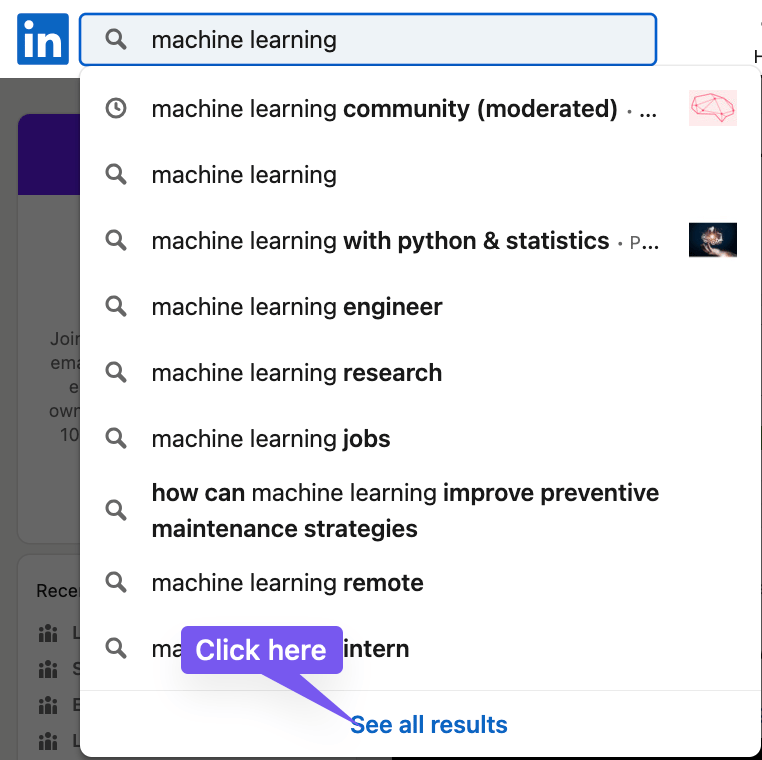
Go ahead and click the See All Results to get to the full Search interface screen.
Scroll down until you find the “People who talk about section”:
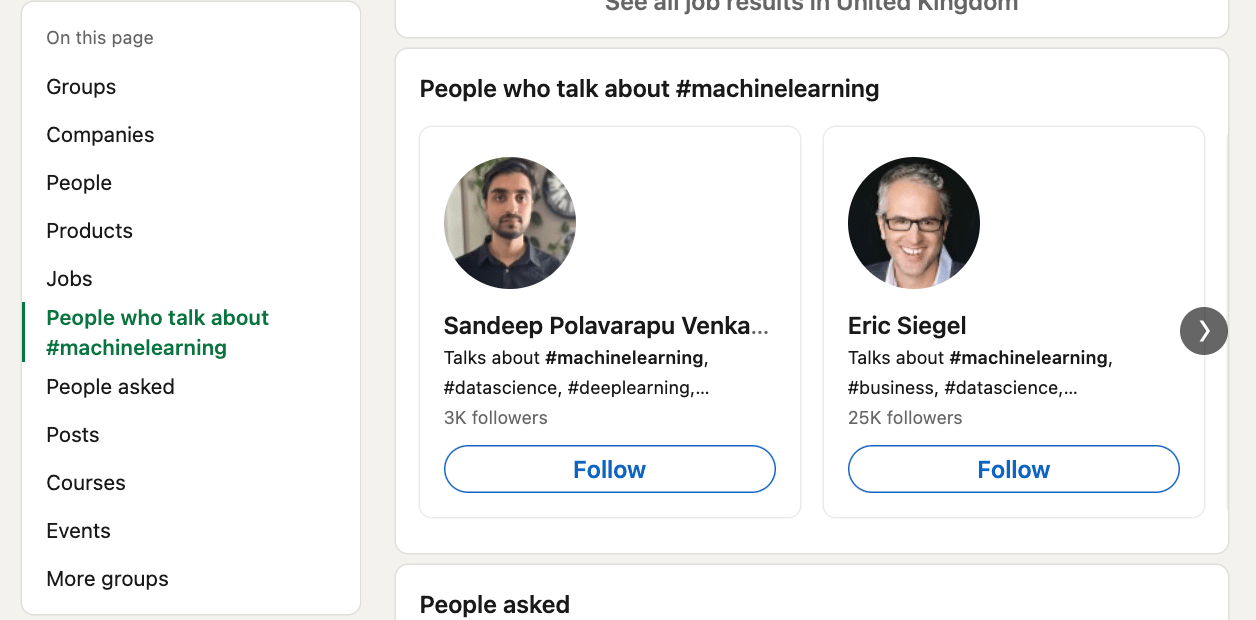
These are people who are known for discussing this topic area on LinkedIn. They are the movers and shakers and the people we want to emulate.
I suggest you Follow all of these people as they will become models for emulation as well as people you’ll want to engage with later.
Right now though we’re interested in grabbing their additional keywords. For example in this screenshot I can see that Eric also talks about #business, #datascience, #predictiveanalytics and #artificialintelligence
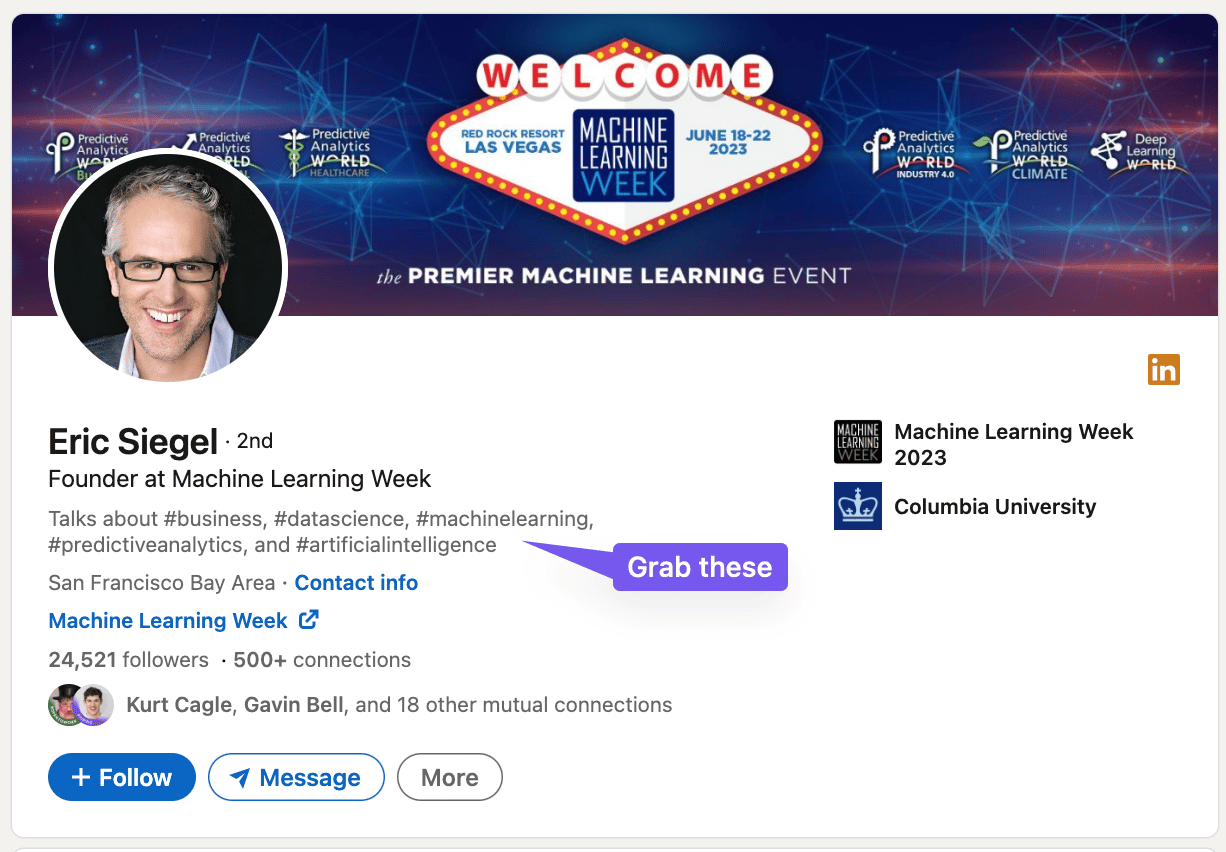
Note the relevant topics down, ideally in a Google Sheet or Excel.
Continue to do this process with multiple influencers for the search you performed.
Then do the same thing for the other keywords you discovered in step 1: ie. neutral networks, deep learning, reinforcement learning etc.
Make sure to only do this with topics you know about. If a topic pops up that you aren’t familiar with: omit it. We want to focus on what we’re good at.
This sounds like a lot of work but very quickly it’ll be the same 20-30 topics popping up again and again.
For instance everyone who is an expert in #machinelearning will tend to have #artificialintelligence as another topic. Once we’ve captured the topic once we can ignore it.
Once you have 20-30 or so you can stop this process and move to the next step.
3. Keywords volume
Once we have our list of 20-30 topics we can move to the next step.
We want to know how popular each topic is on LinkedIn. Thankfully we can check the topic’s volume right in the LinkedIn interace.
In the search bar add #topic ie. #artificialintelligence.
Make sure to use # .
Then click the top result.
Do not press Enter – if you do this won’t work!
Once you’ve clicked the top result you’ll see the topic’s volume:

Note this down next to the topic’s name in your notes document.
Do this for each of the 20-30 topics you’ve collected.
We now want to make a decision. We want to choose a handful of topics we’ll be optimising for.
I like to use:
- 1 Large topic (1M+ followers)
- 3 medium (100k+ followers)
- 5 small (<100k followers)
You’ll find that some topics will have just a few hundred followers. These topics (and related hashtag) are useful for when you are posting specifically about that topic but for now aim at larger topics. I’d say ignore anything below 10,000 followers as a general rule.
This is manual process because you need to align to your interests and your skills. And you know these best!
That said, if you are struggling use this prompt to get you started:
Act as a LinkedIn expert
Analyse this table of topics and their follower counts.
Choose 1 large topic (1M+), 3 medium topics (100k-1M) and 5 small topics (10k-100k).
Aim for consistency without overlap to give me the best mix of focus and range. 4. LinkedIn Summary
We’re now going to take your topic keywords, ask you a few questions and align everything with a set of LinkedIn Summary guidelines.
This will generate your long form “About Me” LinkedIn summary text.
To get to this you’ll need to answer a few questions. I’ve pre-built the prompt to ask you the questions and collect the information. Give as much detail as possible for best results.
Here’s the prompt:
Act as a LinkedIn expert
Help me write an professional summary for my LinkedIn Programme
It should be optimised for the following keywords:
Most important: [Large Topic]
Medium importance : [Medium topics x3]
Low importance : [Small topics x 5]
Ask me questions based on the LinkedIn Summary Template below to collect the required information. Provide examples and guidance for each step that are based on my provided keywords. Then move to the next question.
#LinkedIn Summary Template Begins#
[Hook] Start with an interesting hook or fact to grab the reader's attention right away. For example: "As a first generation college graduate and immigrant from [country], I understand the challenges minority students face when pursuing higher education."
[Mission] Explain why you do what you do in 1-2 sentences. What drives you professionally? For example: "I am passionate about helping underrepresented students access quality education and mentoring."
[Expertise] Highlight your background, years of experience, and qualifications in your industry/field. For example: "I have over 10 years of experience in higher education administration and student advising."
[Skills] Call out 2-3 of your key skills or areas of specialty. For example: "I specialise in developing mentoring programs, advising first-generation college students, and designing inclusive curriculums."
[Proof] Provide a statistic, award, or data point that demonstrates your capabilities and expertise.
[Interests] Mention 1-2 professional interests that indicate what you can help readers accomplish. For example: "I'm interested in collaborating with faculty to enhance diversity, equity and inclusion on campus through new programs and initiatives."
[Call to Action] End with a call to action and your contact info. For example: "I would love to connect with other professionals committed to this work. Feel free to reach out to me at [email] or [phone]."
Break up long paragraphs for easier reading. Keep the summary genuine, and focus on showcasing professional value. Highlight what makes me unique while communicating how I can help my ideal connections.
#LinkedIn Summary Template Ends#
Prompt Output 💬
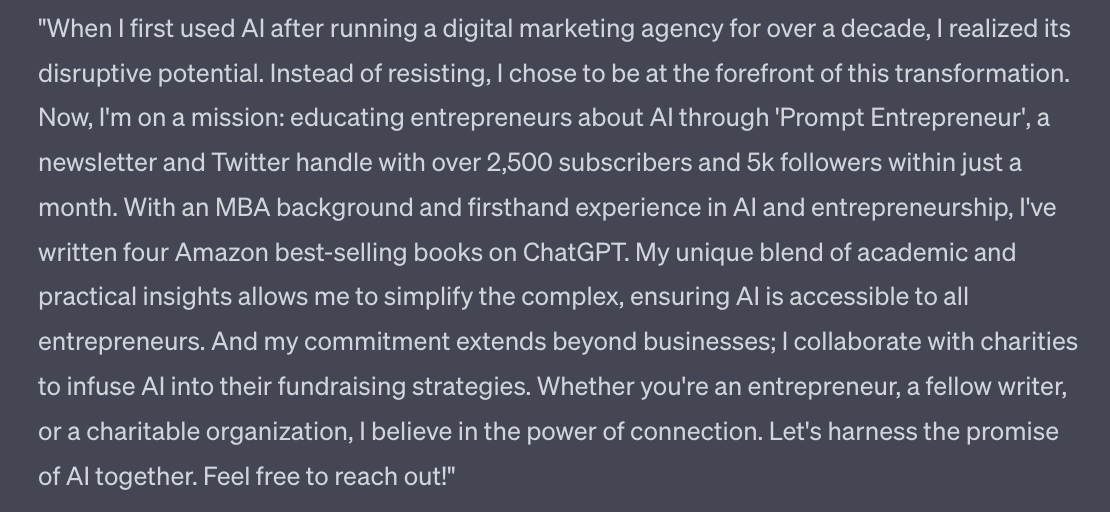
This prompt will generate the first draft and capture the basics. Tweak it to your liking and then use this prompt:
Expand this to 2400 characters. Adjust formatting for readability.
[Copy/paste first draft]Prompt Output 💬
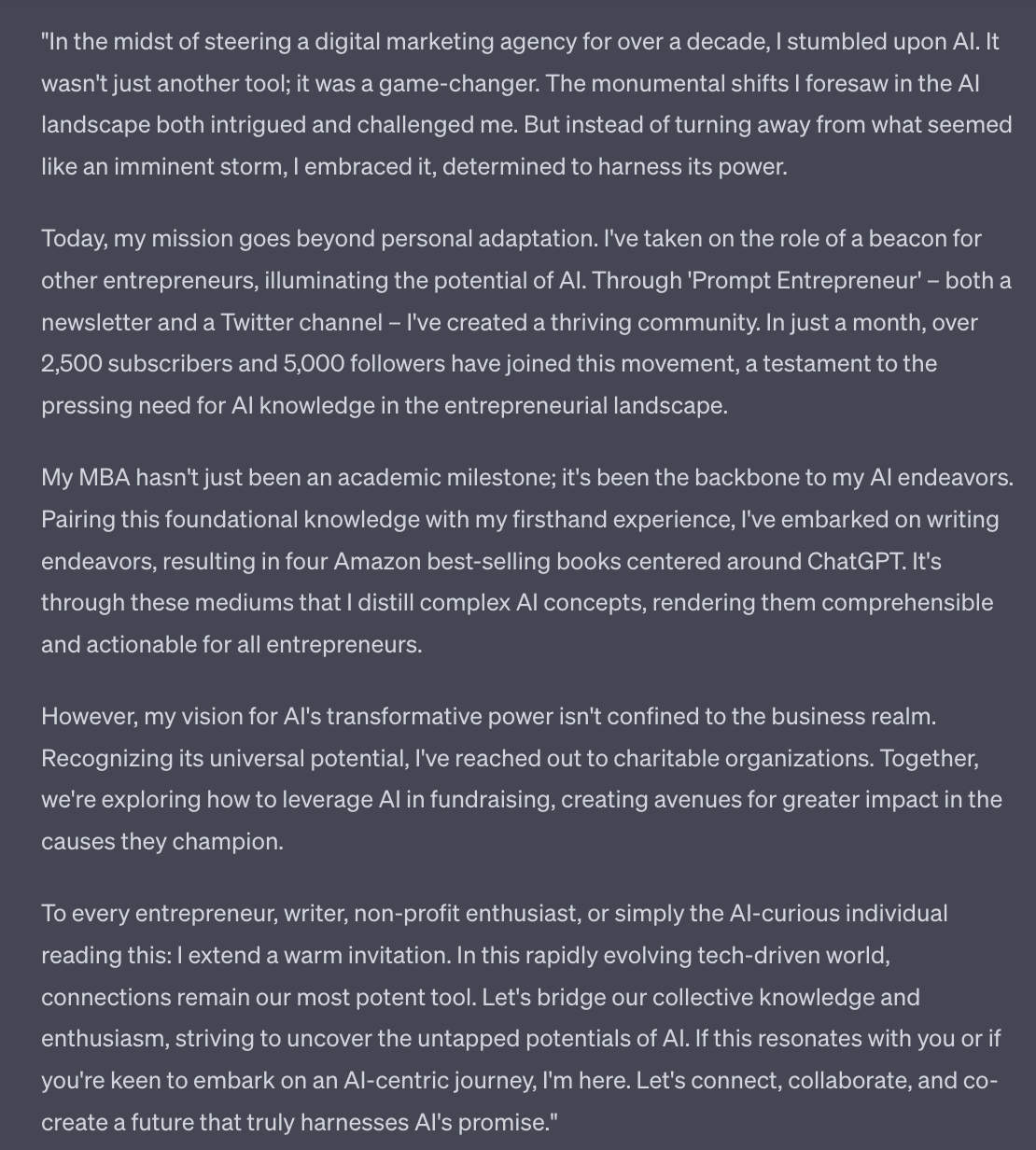
Better!
As always, tweak and rewrite for your own style and tone of voice. ChatGPT is great for drafting but make sure to rewrite so it doesn’t sound like an AI!
5. Headline
The culmination of this work is now to generate a short Headline.
This is what people on LinkedIn see first when they encounter your profile so it’s important to align it with all of the above work.
Here’s a prompt that builds on what we’ve done to generate headline alternatives:
Act as a LinkedIn expert
Write 10 potential headlines for my LinkedIn profile.
The headlines should be between 200-220 characters.
Use both the Headline Guidelines below and my LinkedIn Summary.
#Begin Headline guidelines#
Tailor it to your target audience
Use industry-specific keywords and terminology your audience will recognize
E.g. "Sales Representative: Helping IT professionals provide support anytime, anywhere."
Convey your value proposition
Describe how you can help your prospects and what makes you stand out
E.g. "Saving companies time and money with automated expense reports."
Speak your audience's language
Avoid excessive jargon and use simple, clear language
E.g. "Our software helps developers easily manage their big data apps."
Be accurate and honest
Don't exaggerate or make unsupported claims about your skills
E.g. "5+ years experience in digital marketing and ecommerce"
Use keywords strategically
Include large and some medium keywords if natural.
E.g. "Digital Marketing Manager | SEO & Social Media Specialist"
Add some personality
Give a glimpse into what motivates you and your interests
E.g. "Helping companies grow better at Microsoft"
Include recognitions
Awards and certifications that validate your expertise
E.g. "Top 100 B2B Marketing Influencers of 2022"
#End headline guidelines#
#LinkedIn Summary Begins#
[copy paste LinkedIn Summary]
#LinkedIn Summary Ends#
Use this prompt underneath your other work so that it pulls in your keywords.
Prompt Output 💬

This prompt will generate 10 potential headlines.
Remove the ones you don’t like at all – for example I’d personally get rid of the “Visionary” ones. That’s too much!
Go with the one that jives with you the most. Don’t worry: we can change it later once we start to become more familiar with what our audience wants. We’ll cover this in later Parts.
6. Graphic Elements
There are two primary graphical elements you need to worry about:
- Your profile picture
- Your header banner image
For the profile picture I recommend using a professional looking headshot. You can get this done in a studio or using AI.
Because this is an AI guide (and because I personally hate having my photo taken!) we’ll look at AI options.
Headshots Pro is a strong option here for a range of professional photos. Or on the cheaper side you can check our Retrato.
For your header banner image either hire someone on Fiverr or Upwork or make your own on Canva.
Pulling it together
We’ve covered a lot of foundational ground today and should by now have a solid profile to get started with.
Remember that all of this can (and will) be changed. The main thing right now is momentum. I don’t want you agonising for weeks over how your profile should look and feel. Instead get started and once you know more about the platform make changes.
Tomorrow we’ll be diving straight into Content Creation.
Part 1: LinkedIn Niche
Part 2: LinkedIn Content Creation
Part 3: LinkedIn Audience Engagement
Part 4: LinkedIn Growth
Part 5: Monetising LinkedIn
